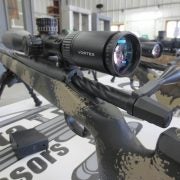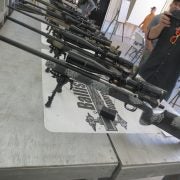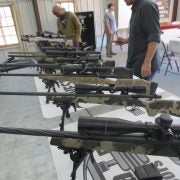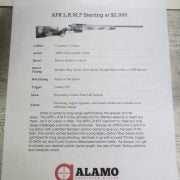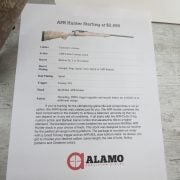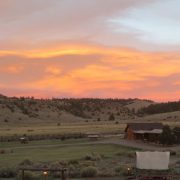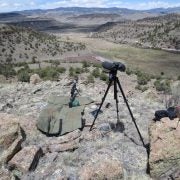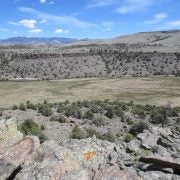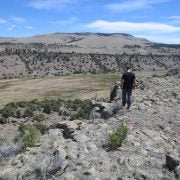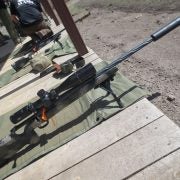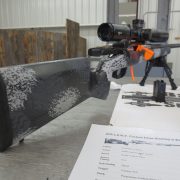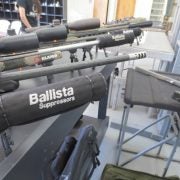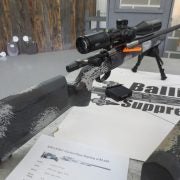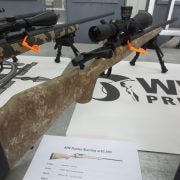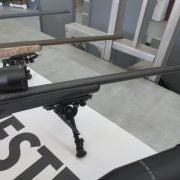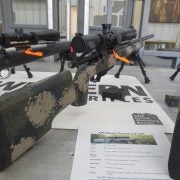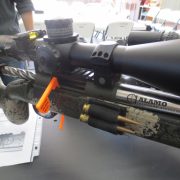To me, the weapons are fun, but anyone can build a weapon well once. It takes good people who know what they are doing to build all the weapons well. If anything, I’m personally fascinated by the stories of how and why people get into the business – it’s those people’s passion that will drive companies forward. As such, it was my pleasure to meet the people behind Alamo Precision Rifles and shoot their rifles – for they are passionate people.

Author’s Note – This review is part of a series stemming from an event that TFB was pleased to join with other writers at Mill Creek Shooting Resort. We want to disclose that all the writers’ expenses were provided by the various companies putting on the event. Alamo Precision Rifles is one of those sponsors.

Jason is on the left. I did not get a good photo of him. My bad, Jason!
Alamo Precision Rifles is based on the partnership of its two principals, Robert and Jason. They are a pairing that if you didn’t see them work together – you’d figure would never work together. Robert is the tech guy and machinist. Quiet with imposing height, yet soft Texas smile, Robert is the machinist and thoroughbred long-range shooter. Jason, short by comparison to Robert, is the prototypical frontman. Brimming with excitement, the former IT worker feels at home next to big bore rifles. The two are a dichotomy of sorts. Robert is so humble it hurts, but Jason is not afraid to tout good work – which is something Robert needs. The work does and should command that positive attention.
Both tired of the common 9 to 5s, the two paired to form Alamo Precision Rifles in Hurst, Texas. The small company is growing rapidly, from just the two to now a handful of employees all focused on one objective – to provide the best value in precision rifles in the industry
THE RIFLES:
Just what is meant by “value”? Too often the word is diluted to mean “cheap” but it would be hard to put the word in the same vicinity as Alamo’s wares. First, and by no means are the weapons inexpensive. The base offerings of the Maverick and Ranger start around $1,800, but it’s what one gets for the money that the weapons are valuable.
For the base rifles, Alamo starts with factory Remington actions. While yes, possible to get a better action from the market, its also more valuable to a customer to start with a decent option and let Alamo work their magic into something valuable. That’s where Robert comes in. He’s been building the rifles for decades and knows how to mill, polish, grind, and bring the best out of the actions.
Once measured, machined, and mated, the actions are Cerakoted (Alamo is a certified Cerakote shop) and ready for bedding into the stock. Of note – all Alamo options are glass-bedded into stocks where possible. Chassis rifles may be different depending on the manufacturer and interface to the action.
The result is perhaps the best that a factory Remington action could ever conceivably achieve. Handling various rifles, I found the fitment exquisite and if one could not see the Remington still engraved on the side of the action – it would be difficult to state it wasn’t a custom action. I would contend they are, as the machining that Robert and crew put into the rifles is almost remanufacturing.
THE L.R.M.F.
Where the majority of Alamo’s work is value-oriented, one should not believe that they do not know how to build the best. For those who’s budget is no constraint or simply want the best, comes the L.R.M.F. or “Long Range Match Fit.” formally. I asked if it actually stood for something a bit more Samuel L. Jackson inspired… but Robert and Jason just smiled and winked.
The L.R.M.F. starts with the best and then improves it from there all based on a custom Alamo Precision Rifles / Curtis action that Robert advised on its development. The action itself is made by Curtis in the Remington footprint, but with some significant updates and changes.
Notably, the action is a three-lug design reducing the bolt throw from the Remington stock 90 degrees to a shorter and faster 60 degree. The cocking piece is tipped with a rollerball, greatly reducing the mechanical friction and increasing the “feel” of bolt rotation, and the cocking piece is easily field-stripped without tools, easing maintenance and cleaning. This action is available in a pinned rail & recoil lug or in an integral billet model with 20 MOA rails standard. For those looking for custom, 0, 10, 30, and 40 MOA rails are possible.
Perhaps the most novel innovation in the action is the smallest feature, the bolt release. Where the stock Remington and multiple other actions feature in-line bolt stops, the Curtis uses a transverse design. This seemingly small change enhances the reliability of the system. In the in-line designs, the pin takes nearly all the force of the bolt’s rearward movement. On the APR/Curtis action, the side of the part itself takes the force, the pin is only there to pivot.
From there, the action is further enhanced with optional DLC coating. DLC, or “Diamond Like Coating” is a PVD applied high carbon content coating that enhances hardness, corrosion resistance, and lubricity. All combined, the action is smooth, with minimal bolt wobble, even when at the rear.
The stock is a custom carbon fiber stock offered only to custom rifle builders. Similar in shape and feel to the McMillan A-series and Greyboe Renegade stocks. It features a long forearm, flattened forearm bottom, and an excellent recoil pad. The stocks are available in multiple colors. It interfaces nicely with the Curtis bottom metal, compatible with AI magazines and featuring ambidextrous integral trigger guard magazine release wings.
SHOOTING THE L.R.M.F.
For the class, where others went with the Maverick rifles, I was fortunate to be handed the LRMF (OK, I admit it, I kind of called it for myself…)

The rifle was configured as follows:
- APR/Curtis Multi-Piece Action – DLC & Cerakoted
- 24″, 6.5 Creedmoor, 1/8 Twist, Bartlein Sendero Contour Barrel, Interrupted Spiral Fluting, Cerakoted
- Timney Trigger
- Custom APR Carbon Fiber Stock (near-final prototype)
- Vortex Viper PST II w/ MOA Reticle
- Harris Bipod
- Ballista Suppressor
The rifle itself is the near perfect set-up that I would personally put together in a bolt-action system. There were some 6mm Creedmoor options there, but being a fan of the 6.5 for its reliability in semi-auto systems, I really wanted to stretch the legs of the 6.5.

We handled the weapons in the classroom for a brief period and I was immediately struck by the “solid” feel of the action to the stock. The glass bedding was perfect and not visible with the excellent mating between the action and stock. Every stock Remington I have played with always has a bit of “play”. This was solid true and through.
The action itself was smooth. The spiral fluted bolt’s flutes were broken nicely with no sharp edges to grab the inside of the action. The large tactical knob was about perfect. Rounded with knurling on the bottom of the knob. It was easy to grab and go.
Getting to the 100-yard range, I immediately came to appreciate the bottom metal. Compatible with AI magazines, the integral trigger guard ambi mag release was easy with the trigger finger, making swaps a breeze. Shooting prone, this was highly appreciated as I did not have to use my support hand and knock the sights off target.
Being an almost exclusively semi-auto shooter the bolt-action triggers are a true blessing and a curse. The Timney unit in my rifle was set to about 2.5 lbs (on my “finger meter”) and with near zero creep of any kind, I had to focus on those good old USMC-taught fundamentals – I was surprised by more than one shot – fortunately without the flinch.

For zeroing and the class, we were provided with factory-new ammunition. In my case, I was given a case of Hornady’s 140 grain ELD Match. Velocity at the muzzle was rated 2710 from the 24″ test barrel with a .464 G1 factory-rated Ballistic Coefficient. We used single-shots only to get the first zero if only because the rifles were so accurate, they didn’t need a “group” for zero. Only after getting rough zero, did we move to 3 and 5 shot groups.
Once zeroed on the weapon, I put my two 5 shot groups on paper. Shooting prone off of a bipod, we glassed the groups at .4 and .5 inches at 100 yards, respectively. Thinking I was king shooter for the day, a fellow student with hand-loads shot a .195 rapid fire from a similar weapon.
After truing at range, we proceeded to the side of the canyon, firing across it and down into the valley on steel targets pre-arranged for the class. Laying on rocks, the rifle came into its own. Under the helpful coaching of Robert (perhaps the best spotter ever), a trued rifle, and an accurate ballistic calculator, we proceeded to ring steel from 500 yards to transonic targets at about 1450 – stretching the limits of what the Creedmoor bullet could do.
The rifle maintained the boring accuracy which was thrilling to get first round hits. After only a few hours, we were dialing and shooting 500-600 yards with regularity and it took shooting past 800 to get the blood flowing again. Perhaps the hardest targets were 6″ poppers set up around 850, across and down the canyon that made calling the wind a challenge. After a few bracketing shots, the steel likewise succumbed to the LRMF’s superiority.
After three days on the rifle and over 500 rounds through it, the weapon and I had bonded. Was tough to give it back after so many successful engagements.The problem is, shooting 500 yards is now easy and I now have to stave off the hankering to shoot PRS matches.
ALAMO PRECISION RIFLES:
The Good:
- They are wizards with standard Remington actions. The “Maverick” and “Ranger” Options get one into true precision for less than $2K.
- All five of the rifles I shot from Alamo were true 1/2 MOA firearms – shooting from bipods with factory ammo. The various hand-loaders present were going sub 1/2 MOA – with me spotting.
- Options exist from tried factory Remington actions to custom Curtis actions that Alamo advised on the development, to true 100% custom weapons.
The Notable:
- Customers can choose from the standard “Excaliber” barrels to using any custom blank from high-end manufacturers including Bartlien, Proof, etc.
- Alamo may be a small short, but Robert has worked with action manufacturers, stock manufacturers, and others in the industry – putting Alamo’s touch across more than their own rifles.
The Bad:
- As of this writing, Alamo only offers Remington or Remington-based actions. I would enjoy seeing what they could do with Tikka, Howa, etc.
THE L.R.M.F RIFLE
The Good:
- Absolute tack-driving boomstick. I shot 2x 5 round groups of 1/2 MOA back-to-back with 140 grain Hornady 6.5 Creedmoor ammo. Boringly accurate at long-range when paired with good glass.
- Custom APR/Curtis action is glass smooth with the roller-bearing cocking piece and DLC coating.
- Striking visuals with the staggered spiral fluting. Can go even fancier with carbon fiber barrels such as Hardy or Proof Research, etc.
The Notable:
- The weapon I shot was a prototype stock and bottom metal piece. The final versions of both (both at the event), are good to go.
- The action is available in single-piece form (Curtis Vector) or in removable rail and lug form (Axiom), per shooter’s choice.
The Bad:
- Price will be a major buying decision factor. The L.R.M.F. starts at $2,999 with easily ticked boxes past $4,000
FINAL THOUGHTS:
No long-range class is enjoyable without capable long-range rifles. Simply put, if the rifle can’t shoot, trying to reach out and ping targets goes from an enjoyable, yet challenging affair to a mind-boggling frustrating boondoggle and waste of ammunition. As such, it’s critical to have a good tool for the job.
And that’s what Alamo Precision rifles are – good tools. In that respect, Alamo is unique. Rather than focusing on the absolute ultimate in precision rifle capability (which they do quite well), Alamo primarily focuses on creating the most value for the money. The vast majority of their builds use factory Remington actions, trued and paired with solid components to create a sub $2K semi-custom precision rifle that actually is precise.
To the L.R.M.F. that I shot, it was and is a remarkable weapon. Even with prototype parts, it was a cohesive machine that eeked every ounce of my shooting ability – and then showed me where I did not measure up. Its a humbling affair for a critic to be critiqued by his rifle.
The rifle did listen to input and consistently released rounds on steel well past 1,000 yards. Paired with the Vortex PST II glass and Ballista suppressor, shooting off the side of the canyon was exhilarating. Coached by Robert of Alamo, first-shot hits were common. The rifle was simply superb.
Alamo, Robert, Jason, and the team are good people. Ones that you can have confidence in working with. So, if you are looking for a solid rifle at a solid price or pushing unlimited budget dream-builds, remember (the) Alamo.

 Your Privacy Choices
Your Privacy Choices

